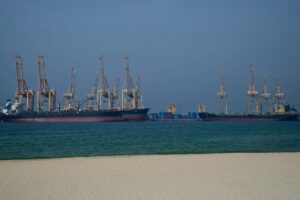
Strolling through Tel Aviv, a tourist from an ex-Soviet country might exclaim, “What a solyanka!” In Russian, solyanka is a traditional soup, consisting of whatever ingredients are on hand. By calling the crowd a solyanka, the tourist wouldn’t be trying to offend anyone, but rather emphasizing the striking diversity of Israeli streets, a vibrant blend of languages and cultures.
What the tourist might not realize is that just around the corner, a grocery store could be selling cold solyanka, a reminder that roughly 13% of Israel’s population traces its roots to the former Soviet Union.
Between the late 1980s and early 1990s, more than 800,000 Soviet Jews made aliyah — the Hebrew term for immigration to Israel, literally meaning “ascent.”
Post-Soviet aliyah trends (Wikimedia Commons)
More than two decades later, new waves of immigration from the same region began to arrive. The “Putin Aliyah” occurred between 2014 and 2021, and “War Aliyah” began in 2022 after Russia’s full-scale invasion of Ukraine. Together, these recent movements brought over 250,000 new immigrants from the Former Soviet Union (FSU) — proof that the solyanka of Israeli society is still simmering.
Who were former Soviet Jews: Then and now
When Jews from the former Soviet Union began arriving in Israel in the 1990s, many were experienced and established professionals, including scientists, artists, and engineers. Many left behind successful careers over the hope of building new lives in the Jewish state.
Soviet Jews arrive at Ben Gurion Airport, 1991 (Wikimedia Commons)
The journey was anything but easy. Until the fall of the USSR, those who left only had one-way tickets to escape. Many of the 800,000 FSU Jews were stripped of their citizenship and were only allowed to carry a limited sum of cash, forcing them to leave behind most of their savings. Even though higher education in the Soviet Union was free, many emigrants faced situations where they were asked to pay for their degrees while going through customs in what became known as a “diploma tax” — a government-imposed fee for taking their degrees abroad. The “diploma taxes” ranged from around $5,000 for a bachelor’s degree to $25,000 for doctoral holders, roughly $175,000 in today’s dollars.
By the late 1980s, the “diploma tax” had mostly become history, but new challenges emerged. For example, due to restrictions on cash, leaving with gold jewelry — which could be smuggled out more easily — became extremely popular. But that, in turn, made them targets. As the Soviet system weakened, organized crime filled the void. Entire families were attacked and extorted by criminals right before their departure. Despite these risks, most families decided to make aliyah together, knowing there was no guarantee of future contact.
Former Prime Minister Yitzhak Rabin shakes hands with new Russian immigrants on their flight from Russia to Israel, on April 27, 1994. (Photo: Avi Ohayon)
Fast-forward to the 2010s, and a new wave of post-Soviet aliyah began: one shaped by different circumstances, but similar anxieties.
The 2014-2021 “Putin Aliyah” consisted of middle-class professionals from Russia, Belarus, and Ukraine, who saw creeping authoritarianism and decided to leave before things got worse. Most never imagined that they would be escaping full-scale war and dictatorship.
The “Putin Aliyah” can be seen as an unforced, educated wave of immigration., Most who left during this period did so by choice, not desperation, believing that they could freely visit their home country. Many migrated with only their immediate family members, or even solo, viewing Israel as a new opportunity rather than a permanent escape.
Passengers disembark from an airplane carrying Jewish immigrants fleeing the war in Ukraine, upon arrival in Israel’s Ben Gurion Airport, on March 6, 2022. (Photo by Menahem Kahana/AFP via Getty Images)
The “War Aliyah,” which started in 2022 after the Russian full-scale invasion of Ukraine, looked very different. This wave was far less organized and far more urgent. Sociologist Aleksei Gusev, who studied the sociological portrait of the immigration wave that started in 2022, described the struggle of many Western countries as a bureaucratic issue, where the system didn’t know how to absorb highly qualified migrants who were forced to relocate. Israel’s system, however, turned out to be much more prepared than many other countries. Decades of experience integrating similarly situated immigrants from the former Soviet Union and Iran gave it a framework to respond quickly and effectively.
Still, the picture was complex. A significant percentage of olim hadashim (Hebrew for new immigrants) were young men, escaping the threat of being drafted. Others were families uprooted with little notice. Together, they represented a mix of pragmatism and survival.
Mass bar mitzvah for 1000 ex-Soviet boys organized by the Gutnick Centre at the Western Wall in Jerusalem, 6 April 1995.
(Government Press Office of Israel)
Systematic integration
Right after the arrival of the 1990s aliyah, Israel faced a challenge unlike anything in its history. Within a few short years, nearly a million new residents entered a country of only about five million people; olim hadashim nearly doubled Israel’s unemployment rate. Cases where engineers swept floors or academics cleaned toilets were quite widespread. For many new immigrants, their first years in Israel meant starting completely from scratch.
Israel’s defense minister, Avigdor Lieberman, meets with Secretary of Defense Jim Mattis at the Pentagon in Washington, D.C., March 7, 2017. (DOD photo by U.S. Air Force Staff Sgt. Jette Carr)
Most of the newcomers spoke little or no Hebrew. Intensive language programs, known as ulpanim, became crucial. Over time, these efforts paid off. Within a decade, the Russian-speaking community built newspapers, TV channels, cultural centers, and political parties. Avigdor Lieberman’s Yisrael Beiteinu party, for instance, rose directly out of this immigrant base. It is crucial to keep in mind that almost a decade had passed before these successes; they came after years of economic hardship, linguistic struggle, and social adjustment.
Israel, however, learned important integration policies and techniques from that experience. Financial aid, including cash stipends, housing aid, health coverage, and tax relief, proved its importance in the 90s aliyah wave. Today, the amount of aid has been elevated, and in 2022, a family of two — including a parent and a minor — was able to get around 2500 shekels (around $750) of financial support immediately upon arrival. Notably, the Israeli government took immediate action to support new olim with financial and legislative support, especially by simplifying the process of gaining citizenship and organizing mobile immigration centers in Ben-Gurion airport to issue documents and connect new arrivals with housing and jobs.
One of the biggest lessons from the 1990s was the need to recognize foreign credentials. Back then, one of the main problems was that many highly educated immigrants found their degrees dismissed or devalued. In response, Israel launched reforms in 2023 to expedite licensing for immigrant doctors, engineers, and other professionals. Moreover, specialized ulpanim have opened, like “Hebrew for Doctors,” designed to help skilled newcomers enter the workplace faster.
Unfortunately, gaps still remain. Many of the reforms are consolidated in the fastest-growing industries, such as technology, healthcare, and engineering. Immigrants with creative professions are left out of these specialized programs. Academics and teachers often struggle with finding Israeli-based jobs. While remote work provides flexibility to some olim, high living costs and lower purchasing power in Israel compared to their home countries create additional strains.
Personal integration, relationships between aliyah waves
In 2022, a post in a Russian-speaking Facebook group asked where one could find a pumpkin spice latte in Israel, a seasonal favorite in Russia as autumn begins. What started as a simple question turned into a big dispute in the Olim community, eventually giving this newest wave of immigrants an unofficial name.
While the 1990s influx is often called the “sausage aliyah,” a tongue-in-cheek nod to late Soviet food shortages and hinting that Olim moved in search of a better life, the 2020s newcomers became jokingly known as the “pumpkin latte aliyah.” The contrast between the two nicknames captured more than just cultural quirks — it revealed the generational divide between those who built new lives in Israel three decades ago and those arriving today.
Hebrew classes at an ulpan in Holon, June 2000 (Government Press Office of Israel)
Tensions between the two waves were real. The 1990s olim arrived in a country with no infrastructure, community networks, or even reliable information in Russian and had to build everything from scratch. The 2020s olim, by contrast, benefited from globalization, remote jobs, and pre-existing Russian-speaking communities. Still, despite these advantages, many faced new forms of alienation.
And here, a subtle tension arises between the two aliyah generations in which attachment to one’s home country became a bone of contention. between two aliyah waves. The olim of the 1990s largely accepted that Israel was their permanent home. Many from the 2010s and 2020s, by contrast, maintain closer attachments to their home countries — working remotely for companies abroad or traveling back when possible. That difference in outlook has become one of the key distinctions between the “first” and “second” waves of post-Soviet aliyah.
But in time, the waves have begun to converge. Newcomers created NGOs, cultural projects, and support networks to help each other — and, surprisingly, many from the earlier waves joined in. What once divided the “sausage” and “pumpkin latte” olim now connects them: a shared effort to build community in a country that continues to redefine what it means to come home.




